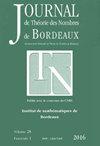The natural extension of the Gauss map and the Hermite best approximations
IF 0.3
4区 数学
Q4 MATHEMATICS
引用次数: 1
Abstract
Following Humbert and Lagarias, given a real number θ, we call a nonzero vector (p, q) ∈ Z × N a Hermite best approximation vector of θ if it minimizes a quadratic form f∆(x, y) = (x− yθ)2 + y 2 ∆ for at least one real number ∆ > 0. Hermite observed that if (p, q) is such a minimum with q > 0, then the fraction p/q must be a convergent of the continued fraction expansion of θ. Using minimal vectors in lattices, we give new proofs of some results of Humbert and Meignen and complete their works. In particular, we show that the proportion of Hermite best approximation vectors among convergents is almost surely ln 3/ ln 4. The main tool of the proofs is the natural extension of the Gauss map x ∈ ]0, 1[→ {1/x}.高斯映射的自然扩展与Hermite最佳逼近
根据Humbert和Lagarias,给定实数θ,我们称非零向量(p,q)∈Z×N为θ的Hermite最佳逼近向量,如果它最小化了至少一个实数∆>0的二次形式f∆(x,y)=(x−yθ)2+y 2∆。Hermite观察到,如果(p,q)是q>0的最小值,那么分数p/q必须是θ的连续分数展开的收敛。利用格中的极小向量,我们给出了Humbert和Meignen的一些结果的新证明,并完成了他们的工作。特别地,我们证明了Hermite最佳逼近向量在收敛点中的比例几乎肯定是ln 3/ln 4。证明的主要工具是高斯映射x∈]0,1的自然扩展[→ {1/x}。
本文章由计算机程序翻译,如有差异,请以英文原文为准。
求助全文
约1分钟内获得全文
求助全文
来源期刊

Journal De Theorie Des Nombres De Bordeaux
MATHEMATICS-
CiteScore
0.60
自引率
0.00%
发文量
35
期刊介绍:
The Journal de Théorie des Nombres de Bordeaux publishes original papers on number theory and related topics (not published elsewhere).
 求助内容:
求助内容: 应助结果提醒方式:
应助结果提醒方式:


